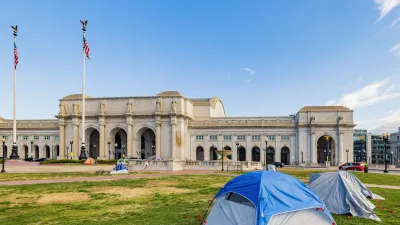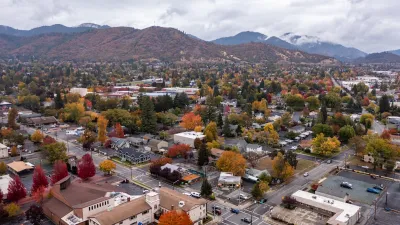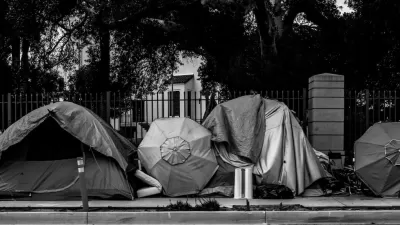The role of business improvement districts in criminalizing homelessness reflects a tension between private interests and public space, Rob Waters writes.

With more Americans becoming homeless every year, the question of how cities should respond to the crisis has grown increasingly urgent. In Next City, Rob Waters unpacks the debate between homeless advocates and business improvement districts over policing and criminalization—a conflict that he says is truly about "the degree of influence that private interests should exercise over the management of public space."
"Today's conflicts between homeless activists and BIDs have their roots in 'slum clearance' efforts of the 1950s and 1960s that razed huge chunks of city neighborhoods and displaced hundreds of thousands of residents, mostly low-income people of color," Waters writes.
BIDs operate in cities around the country, and are designed to allow property owners to collectively pay into area improvements beyond those provided by local government. But on top of street cleaning and marketing campaigns, BIDs have gained a reputation among critics as the "foot soldiers of gentrification" for deploying "private armies" that funnel homeless residents into the legal system. Following instances of harassment, violence, and seizure of property, Waters reports, a study from UC Berkeley suggested that BIDs regularly "exclude homeless people from public spaces in their districts through policy advocacy and policing practices."
Waters delves further into BID activities and speaks to BID representatives about their attempts to attract visitors and raise property values. He also notes a different approach taken by one Community Benefit District in San Francisco: providing tenant-landlord mediation to prevent eviction (a key driver of homelessness) and installing public toilets and needle disposal to improve street cleanliness and public health.
FULL STORY: No Place Left to Go: Business Districts Keep Homeless Populations on the Move

Study: Maui’s Plan to Convert Vacation Rentals to Long-Term Housing Could Cause Nearly $1 Billion Economic Loss
The plan would reduce visitor accommodation by 25,% resulting in 1,900 jobs lost.

North Texas Transit Leaders Tout Benefits of TOD for Growing Region
At a summit focused on transit-oriented development, policymakers discussed how North Texas’ expanded light rail system can serve as a tool for economic growth.

Why Should We Subsidize Public Transportation?
Many public transit agencies face financial stress due to rising costs, declining fare revenue, and declining subsidies. Transit advocates must provide a strong business case for increasing public transit funding.

How to Make US Trains Faster
Changes to boarding platforms and a switch to electric trains could improve U.S. passenger rail service without the added cost of high-speed rail.

Columbia’s Revitalized ‘Loop’ Is a Hub for Local Entrepreneurs
A focus on small businesses is helping a commercial corridor in Columbia, Missouri thrive.

Invasive Insect Threatens Minnesota’s Ash Forests
The Emerald Ash Borer is a rapidly spreading invasive pest threatening Minnesota’s ash trees, and homeowners are encouraged to plant diverse replacement species, avoid moving ash firewood, and monitor for signs of infestation.
Urban Design for Planners 1: Software Tools
This six-course series explores essential urban design concepts using open source software and equips planners with the tools they need to participate fully in the urban design process.
Planning for Universal Design
Learn the tools for implementing Universal Design in planning regulations.
City of Santa Clarita
Ascent Environmental
Institute for Housing and Urban Development Studies (IHS)
City of Grandview
Harvard GSD Executive Education
Toledo-Lucas County Plan Commissions
Salt Lake City
NYU Wagner Graduate School of Public Service





























